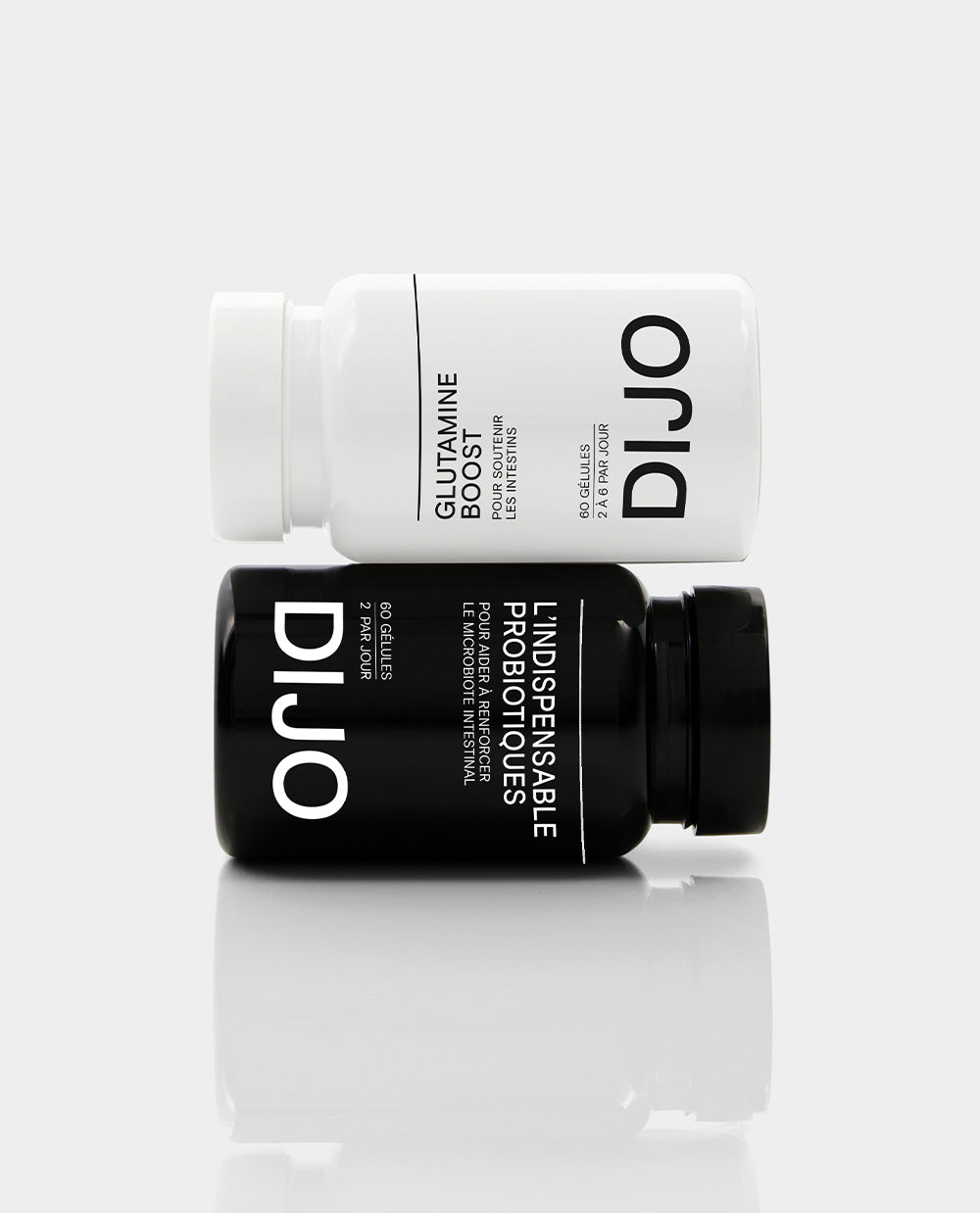What you must remember :
- Adenomyosis is also called “internal endometriosis of the uterus”.
- It is characterized by the infiltration of endometrial cells (uterine lining) into the myometrium (uterine muscle) due to an abnormality at their junction.
- The exact causes of adenomyosis remain largely mysterious, but several theories have been put forward.
- Different tests can be prescribed by health professionals to confirm the diagnosis of adenomyosis (pelvic ultrasound, pelvic MRI, etc.).
- Adenomyosis is commonly seen in women facing fertility problems.
- Diet and stress management are two examples of interesting areas to work on to naturally relieve the symptoms associated with adenomyosis.
What is adenomyosis?
Adenomyosis, also called “ internal endometriosis of the uterus”, is characterized by the infiltration of cells from the endometrium (uterine lining) into the myometrium (uterine muscle) due to an abnormality at their junction. This causes thickening of the uterine lining and is responsible for many hemorrhages. This gynecological disease is common and benign , that is to say it does not threaten the woman's vital prognosis. However, some forms of adenomyosis are very painful and impact daily well-being.
The different forms of adenomyosis:
- Diffuse adenomyosis: The different foci are scattered throughout the myometrium.
- Focal adenomyosis: The different foci are located in a more limited area of the uterine muscle.
-
External adenomyosis: This is when deep pelvic endometriosis infiltrates within the myometrium.
Be aware that pelvic endometriosis and adenomyosis are frequently linked. However, exceptions exist: a woman can suffer from adenomyosis without having endometriosis, and vice versa.
Adenomyosis is a gynecological disease which affects approximately 11 to 13% of women , a quarter of whom are between 36 and 40 years old . In addition, 6 to 20% of these women have both adenomyosis and endometriosis.
What causes adenomyosis?
The exact causes of adenomyosis remain largely mysterious, but several theories have been put forward. Among them, the retrograde infiltration theory suggests that endometrial fragments travel in the reverse direction during menstruation. Hormonal fluctuations , chronic inflammation and genetic factors could also play a role. It was noted that adenomyosis was often found in women who had several pregnancies or in those with endometrial hyperplasia, that is to say a very developed uterine lining (endometrium). However, research is ongoing to elucidate these complex mechanisms and better understand this gynecological disease.
What are the symptoms of adenomyosis?
Did you know that 2 out of 3 women with adenomyosis do not have symptoms? Indeed, in most cases, this disease remains silent. However, in some women it can also send clear signals through a range of symptoms. Although these symptoms may vary from person to person, here are the common manifestations associated with adenomyosis:
-
Menorrhagia: This is heavy and prolonged bleeding, lasting more than 7 days. They are frequently accompanied by blood clots and can lead to anemia and/or chronic fatigue . This concerns approximately 50% of women affected by adenomyosis.
-
Dysmenorrhea: These are painful periods, of an intensity that can sometimes be very strong, and can harm the daily life of women with adenomyosis. Pelvic pain can persist throughout the month, not just during periods. Menstrual pain can be likened to very painful cramps. Dysmenorrhea is encountered in 30% of cases of adenomyosis.
-
Metrorrhagia: This is blood loss occurring outside of menstruation periods. 20% of women with adenomyosis present this symptom.
-
Dyspareunia: Adenomyosis can lead to pain during sexual intercourse since it can increase the pressure exerted on the affected area.
-
Bloating and abdominal discomfort: Some women experience abdominal swelling and general discomfort, similar to what one might feel during menstruation.
- Fatigue and irritability: Pain and excessive bleeding can lead to fatigue and irritability, affecting mood and quality of life.
Fortunately, there are natural treatments that can relieve women of these symptoms and improve their daily lives.
How is adenomyosis detected?
In the case of suspected uterine endometriosis, various tests may be prescribed by the obstetrician-gynecologist in order to confirm the diagnosis. First, a pelvic ultrasound is performed to see if the size of the uterus has increased, if it has lost its initial triangular shape, or if the uterine muscle is thickened and inflamed. In addition, as a second intention, a pelvic MRI can also be considered when there is suspicion of associated endometriosis. It allows you to visualize the extent of adenomyosis inside the uterus, but also to identify other lesions associated with endometriosis. Imaging can be used to differentiate adenomyosis from uterine fibroids. Finally, in the event of an infertility assessment, the doctor may prescribe a hysteroscopy (viewing the uterus from the inside using a camera) or a hysterosalpingography (x-ray examination).
What are the risks associated with adenomyosis?
Adenomyosis can cause several risks and complications, although these effects may vary from person to person depending on the severity and extent of the disease. Here are some of the risks associated with adenomyosis:
-
Chronic pain: Intense and persistent pelvic pain is one of the most common risks linked to adenomyosis. These pains can have a significant impact on the quality of life and emotional well-being of those affected.
-
Heavy bleeding and anemia: Adenomyosis can cause excessively heavy and prolonged periods, sometimes leading to anemia due to excessive blood loss. Anemia can cause fatigue , weakness, and other health problems.
-
Infertility and high-risk pregnancy: Although the precise mechanisms are not fully understood, adenomyosis can increase the risk of infertility in some women by affecting the lining of the uterus and disrupting embryo implantation. . The slightest risks of complications during pregnancy are miscarriage (risk multiplied by 2 in these women), preeclampsia or premature birth.
- Hormonal alterations: Adenomyosis can influence hormone levels in the body, which can lead to hormonal imbalances and symptoms such as irregular menstrual cycles.
Natural treatments to relieve adenomyosis
Adenomyosis, this complex and sometimes disconcerting gynecological disease, can bring its share of challenges to daily life. Faced with a growing quest for natural solutions that respect their body, many women are turning to natural alternatives to relieve their symptoms in a gentle and healthy way. Here are the possible natural treatments.
1 - Balanced diet: Nourish the body to soothe the mind
A balanced, nutrient-rich diet can play an important role in managing the symptoms of adenomyosis. Here are some of our recommendations to relieve your adenomyosis:
-
Omega-3: Found in fatty fish (such as salmon and mackerel), walnuts and flaxseed, they have anti-inflammatory properties that could help alleviate symptoms.
-
Dietary fiber: Present in vegetables, fruits, oilseeds (almonds, nuts, etc.) and legumes (lentils, peas, beans, etc.), they promote intestinal health and can help regulate hormones.
-
Foods rich in iron: To prevent anemia due to heavy menstrual bleeding, include sources of iron, such as dark leafy green vegetables, lentils and lean meats, in your diet.
-
Antioxidant-rich foods: Antioxidants, found in colorful fruits and vegetables such as berries, citrus fruits, spinach and carrots, can help reduce inflammation and support the immune system .
-
Anti-inflammatory foods: Certain anti-inflammatory foods are known for their ability to reduce inflammation in the body. Among them, we find in particular leafy vegetables (broccoli, etc.), lentils, turmeric, olive oil.
- Hydration: Make sure you stay well hydrated by drinking enough water throughout the day, i.e. 1.5 to 2L of water per day. To help you, remember to take your bottle with you everywhere.
2 - Phytotherapy: The power of plants
Phytotherapy is a very interesting natural treatment for adenomyosis. Herbs and medicinal plants have been used for centuries to relieve various ailments, and adenomyosis is no exception. Indeed, certain plants used in herbal medicine can offer relief from the symptoms of adenomyosis due to their anti-inflammatory, analgesic and hormonal properties. Here is a non-exhaustive list of plants that could benefit you:
-
Turmeric: It is well known for its anti-inflammatory properties thanks to its active component, curcumin. It may help reduce inflammation associated with adenomyosis, which could help alleviate pelvic pain.
-
Ginger: It has analgesic and anti-inflammatory properties that could help reduce pain and discomfort. It can also support blood circulation and promote better digestion .
-
Chamomile: It is renowned for its soothing and relaxing properties. It can help alleviate stress and anxiety, which can worsen adenomyosis symptoms.
-
Licorice Root: It has anti-inflammatory properties and may support hormonal balance by helping to regulate estrogen levels.
-
Raspberry Leaves: Raspberry leaves are traditionally used to support uterine and hormonal health. They can help strengthen the uterus and promote healthy hormonal balance.
-
Agnus-castus (Chasteberry): This plant is known for its hormonal regulating properties. It may be helpful in balancing estrogen and progesterone levels, which could help alleviate the symptoms of adenomyosis.
Consider integrating them into your food routine or in the form of food supplements.
3 - Food supplements: Choosing valuable allies
Certain food supplements can be very interesting natural treatments to relieve the symptoms associated with adenomyosis. Among them, we find in particular probiotics and glutamine. First, probiotics help maintain the balance of the gut microbiota , which can be beneficial for reducing inflammation and improving the immune system, important elements in the management of adenomyosis. As for glutamine, it is known to support gut function and help reduce inflammation.
At DIJO, to relieve you, we have created the Regenerated Intestine pack which combines two products: Essential Probiotics and Glutamine . This pack will help you restore balance within your intestinal microbiota and restore the integrity of your intestinal mucosa. In other words, it's the perfect duo to repair the flaws and repair your shield that is the intestines! You can say goodbye to uncomfortable digestive problems.
4 - Stress management: Balancing body and mind
Stress can worsen adenomyosis symptoms by triggering inflammatory reactions . Regularly practicing relaxation techniques, such as meditation, yoga, and deep breathing, are examples of natural treatments to help reduce your daily stress, improve your sleep quality, and promote healthy hormonal balance.
5 - Physical activity: Taking care of your body through movement
Moderate exercise can help strengthen the body, improve blood circulation and reduce pain. This is an effective natural treatment. Choose activities that suit you, such as walking, swimming or pilates, and be sure to listen to your body to avoid overdoing it.
Although natural remedies may provide some additional relief, it is essential to maintain open communication with a healthcare professional. Adenomyosis is a complex disease, and the guidance of a specialist can allow you to make the choices best suited to your case.
















